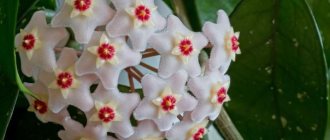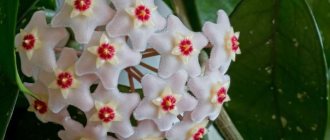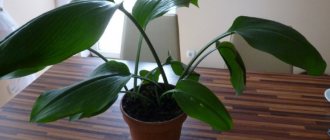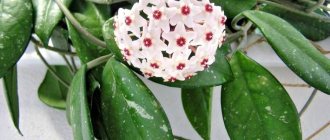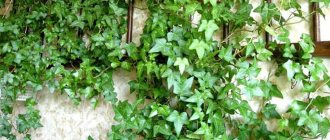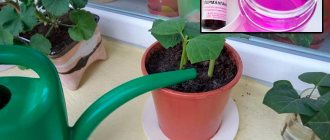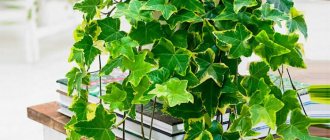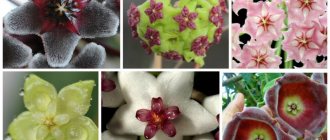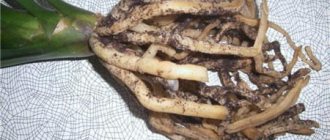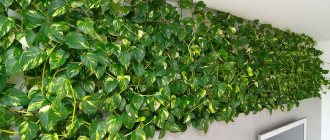Folk beliefs associated with wax ivy
Many gardeners and superstitious people claim that wax ivy should not be kept in the house. Such restrictions are associated with several signs:
- The flowering time of Hoya is associated with a period of problems for its owner. But here too it is worth clarifying the nuances. Trouble awaits the gardener only if the plant blooms its flowers at the wrong time (for example, it blooms twice in a row).
- Ivy expels masculine energy from the home. Quarrels often occur in the family; relationships cannot be called happy. Unmarried ladies are not advised to have wax ivy.
- In the house where hoya is grown, financial problems begin.
In addition, culture is able to report the appearance of enemies :
- If the hoya begins to dry out for no apparent reason, this means that ill-wishers have appeared in the house. The plant absorbs the negative energy of a negative person and begins to fade. In this way, the culture protects its owner.
- Yellowed leaf blades also indicate negative energy in the house. Most likely, a lot of negativity has accumulated in your home, which the culture has absorbed. In this case, the hoya seems to be hinting that family members need to check their health.
Basic rules for caring for Hoya
Hoya Fleshy or Beautiful is most often grown indoors.
, which are unpretentious in care, grow well in apartments and houses. But they require good lighting to bloom, so these types of wax ivy are placed on sunny windowsills. Since both species have thicker leaves, water them only after the top layer of soil has dried. Hoya Kerry requires the same placement and watering.
If your wax ivy has thin leaves
, then the plant requires shading from direct sunlight and regular watering. The soil in the pot should not dry out.
The liana can be placed on a western or eastern window. Plants with fleshy leaves are not afraid of even direct sunlight.
Air temperature
for ivy it should be from +17 to +25 degrees. The plant does not have a pronounced dormant period, so in winter it can be kept indoors. If during the cold season the air temperature in the room drops below +15 degrees, then Hoya the Beautiful may shed its leaves.
In autumn or winter,
As the days get shorter, wax ivy may slow down its growth. At this time, it is necessary to stop feeding and reduce watering. But if an indoor flower is provided with additional lighting, it will begin to grow again.
Spray the plant
not necessary, since the vine with fleshy leaves tolerates dry air in apartments calmly. But to ensure that the leaves remain decorative and that pests do not infest them in dry air, the ivy should be bathed from time to time in a warm shower. You should first cover the soil with polyethylene. If the vine has grown and you can’t remove it, then simply spray or wipe off dust from its leaves. A bush with clean foliage will immediately take on a more decorative and beautiful appearance.
Hoya fertilizer
To feed wax ivy, it is recommended to use fertilizers for succulents. Fertilizers are applied during the active growth of the flower, that is, from spring to autumn. Fertilizers should be used strictly according to the instructions, since their excess will negatively affect the decorativeness of ivy.
Hoya during flowering
If you provide a tropical vine with bright, diffused light, it will bloom beautifully and profusely. But you need to know that during flowering the flower pot cannot be moved from place to place. Otherwise, the buds will begin to fall off.
After flowering, it is not recommended to cut or pick off flower stalks. After some time, buds may appear on them again.
Hoya transplant
Young plants require replanting every spring, and adults, if necessary, are replanted once every three years. The pot is selected 2-3 centimeters larger than the previous one. If you transplant the vine into a larger container, it will grow foliage and may not bloom in the year of transplantation. In a tighter pot, wax ivy will bloom profusely. Therefore, if you want to get more young shoots, then take a larger pot. But it should be taken into account that the largest container size for an adult plant should be 20 cm.
The soil for Hoya should be slightly acidic or neutral, breathable and loose. You can use soil for orchids or prepare it yourself from turf and leaf soil, peat and sand. Pieces of sphagnum moss and charcoal are added to the mixture.
The bottom of the new pot must be covered with drainage. A layer of nutritious soil mixture is poured onto it and a flower is placed, which must be removed from the old container along with a lump of earth. The roots are covered with soil and watered.
Supports and trimming
The liana definitely needs support, otherwise its long shoots will begin to break under the weight of foliage and inflorescences. As supports you can use lattices, trellises, posts, moss supports, all kinds of arcs in the form of arches, rings or hearts. You can hang the hoya on the wall and distribute its shoots on shelves, hooks or on incompletely driven nails.
If you want to get wax ivy in the form of a bush, then the shoots will need to be constantly pinched at the required length.
Hoya can be pruned to form a plant of the size you need. Branches that are too long can be shortened, and unnecessary ones can be cut off completely. Broken and dried branches are also trimmed. To stimulate the appearance of side shoots, the old branch is cut off between the nodes.
It is recommended to carry out pruning using a special pruner or sharp scissors.
Signs by plant type
Fleshy (Carnosa)
This type of hoya is also feared by gardeners. It is believed that the plant scares away all residents of the house except the owner. The only option to get a fleshy hoya is to bring it into the house as a young seedling. In this case, the plant will protect all the inhabitants who were in the house before its appearance.
Bella
There are the same legends about this variety as about other types of wax ivy. However, this plant is considered even more powerful. Culture is capable of expelling not only a spouse from home, but also adult sons.
But on the other hand, Bella protects flower growers from envy and anger. Moreover, the flower saves not only the owner himself, but also his guests from negativity.
The benefits and harms of ivy
Biologists, through numerous studies, have proven that the plant is in no way harmful and does not emit toxins known to science that negatively affect the body.
Based on the research results, we draw the following conclusion: despite the common signs, Hoya bella is an ornamental crop that does not cause any harm to humans or other living beings; it can be grown in premises for any purpose.
The only thing you should beware of when growing this cultivated plant is the overly sweet aroma emitted during the flowering period. In principle, the aroma is pleasant, but when the plant is in a room with a small square area, it can become overly intrusive. Naturally, first of all, this applies to families where there are persons registered with an allergist or children under the age of majority with obvious pulmonary diseases or pathologies.
In addition, when carrying out standard measures for caring for the plant, it is necessary to remember that the juice secreted by the hoya upon contact with the mucous membrane can lead to irritation.
The positive influence of decorative ivy is undeniable. It, like other indoor plants, is actively involved in purifying the air and producing oxygen, which is essential for the human body.
The deciduous part of ivy can and should be used for treatment and preventive measures in the fight against diseases such as carbunculosis and furunculosis.
Of course, the plant requires proper and timely care. You can find out what exactly and how to do it by reading the relevant literature or carefully studying Internet sites on gardening. Only in this way can the decorative appeal of this amazing plant be preserved for quite a long time.
By studying other types of literature, you can understand in which zone to place the plant in order to improve your health, increase your strength and reveal your abilities.
Is it possible to keep a flower at home?
The most important thing in any sign is faith in it. If you are not a superstitious person, then you can safely have any variety of Hoya at home. After all, this is one of the most interesting plants, distinguished by beautiful fleshy leaf blades with a waxy sheen and original flowering.
Hoya perfectly purifies the air, saturating it with oxygen, decorates the interior, and also helps get rid of furunculosis - it is perfectly treated with ivy leaves.
Among the negative properties, it is worth mentioning that blooming hoya has a strong specific odor, which can cause allergies in people with breathing problems. Therefore, it is not recommended to keep this plant in cramped enclosed spaces. In addition, avoid getting hoya juice on your skin - it can also cause an allergic reaction.
Otherwise, the plant will give only positive emotions. Try to believe in good omens. One of them says that wax ivy absorbs all negative energy.
Botanical characteristics
Hoya (Hoya) from the Lastovnevye family can be represented by a shrub, liana or hanging plant. Hoya has strong stems on which opposite leaves are located. The foliage can be leathery or succulent, oval or pointed in shape. Foliage color can be varied. The most popular varieties in indoor floriculture are those with dull green and dark green leaves, as well as plants with green leaves with yellow, cream or pink spots.
The flowers are waxy, with an unusually pleasant and quite pronounced aroma. Umbrella inflorescences can include a different number of relatively small star flowers, the color of which varies depending on the species and varietal characteristics of the ornamental crop. Droplets of nectar on the surface of the flowers only add to the attractiveness of this amazingly beautiful plant.
Where is the best place to put it?
There are several options for arranging a plant in which it will bring good luck to the residents of the house:
- You can put the plant in the bedroom. This will make the relationship between lovers more harmonious and warm. Astrologers recommend choosing a type called Heart of Kerry. This variety even has heart-shaped leaves.
- If you place a flowerpot with a flower in the children's room, it will help your children grow up more independent.
- Also, many gardeners place the plant in the living room or dining room. Hoya helps get rid of fatigue and restore strength after a hard day at work.
Reference! You can even place Hoya in your office. If you constantly look after her and do it competently, she will reward her owner with success in her work. The most important thing is to provide the culture with maximum care.
Whether to place a hoya in your home or not, everyone decides for themselves. Undoubtedly, this plant has more positive properties than negative ones. The flower makes the air cleaner and saturates it with oxygen, and also fights skin diseases and simply decorates the interior.
Difficulties in growing
Hoya is not prone to diseases if properly cared for. Problems with the plant begin when the lighting and watering regimes are disrupted, the room is too cold or dry, and the flower lacks fertilizer.
Possible difficulties when growing hoya:
- Scale insects, spider mites, aphids. These pests attack the leaves of the flower and reproduce well in dry air. If there are few insects, it is enough to remove them from the plant with a cotton swab dipped in alcohol. When the number of pests is large, spray with insecticides according to the instructions indicated on the product packaging. Scale insects, aphids and spider mites
- Root nematode. Signs of damage by this pest are stunted growth and yellow-brown areas on the roots. The flower must be removed from the pot, the roots washed in warm water at a temperature of +50°C and treated with an insecticide. After this, the hoya is transplanted into fresh substrate.
- Lack of flowering. Causes may include improper temperature and pruning, excess fertilizer or lack of sunlight. To admire how hoya blooms every year, you need to keep it in a cool room in winter, limit watering and not apply fertilizer. With the onset of spring, the flower is placed in a warm and well-lit place, fed and watered abundantly.
- Yellowing of leaves. Occurs when growing a plant in a hot room or insufficient lighting. The problem can be eliminated by adjusting the air temperature in the room and moving the hoya pot to a brighter place.
- Falling leaves. The reason is cold water when watering and too dry air in the room. To save the hoya, the air in the room is intensively humidified, and only warm water is used for watering.
- Slow growth, small leaves. In winter, such symptoms should not cause alarm - the hoya simply goes into a dormant state. In spring and summer, the plant may not grow well due to a lack of nitrogen-containing fertilizers. To eliminate the problem, add fertilizer.
- Powdery mildew. A sign of this fungal disease is a white coating on the leaves, which subsequently spreads to the stems and inflorescences. The problem occurs as a result of poor ventilation of the room and dry air. To treat a flower, it is treated with a copper-soap solution and the humidity in the room is increased.
- Root rot. It occurs when overwatering, especially in the cold season, and often leads to the death of the plant. The Hoya is removed from the old pot, the roots are treated with Bordeaux mixture and the flower is transplanted into a new substrate, reducing watering. But this procedure does not guarantee that the plant can be saved. Therefore, it is better to cut several cuttings and root them to grow a new flower.
Hoya propagation
The exotic ornamental plant propagates in 4 ways:
- cuttings;
- leaves;
- seeds;
- layering.
Each method has its own characteristics:
- Cuttings . You need to take last year's hoya stem, select an area with three internodes and 2-3 leaf pairs. Cut the cuttings and treat the damaged areas with a fungicide or antiseptic. Place the planting material in pre-prepared seedling soil and water until young shoots sprout.
- Reproduction by layering . If there is a healthy and strong shoot on the hoya stem, it can be placed in a pot with soil and watered periodically. Secure the sprout with a hairpin - and now all that remains is to wait for it to take root.
- Sowing seeds . For this, plant grains collected in the year of their upcoming sowing are used. Old seeds will not work - they simply will not sprout.
- Reproduction by leaves. The selected green mass should be placed in the soil and the pot should be covered with film. The roots of the leaf grow quite quickly, but it does not always manage to take root.
To successfully root a new plant specimen, it is necessary to choose the right planting material. Therefore, take only the freshest seeds, strong petioles and leaves, strong and young cuttings.
Cuttings
If you want to be sure that you will get a new hoya plant, then this is the best method to choose. Because Hoya cuttings take root quite quickly and without any difficulties. There is no need to choose cuttings that are too long, the main thing is that there are two nodes and several pairs of leaves on the shoot.
There are two ways to root a cutting. You can do this in water. To do this, select a container where you will place the cuttings and wrap it in foil. You only need to leave a few holes where you will then insert the cuttings. Only the top pair of leaves needs to be left on them, and everything else is pushed through the foil so that the lowest node is necessarily in the water. Before this, it is recommended to treat the lower part of the cuts with a special solution that stimulates root growth.
Place the dishes with cuttings in a room with high humidity and a temperature of at least twenty-two degrees. To achieve high humidity, you can put a plastic bag directly on the cuttings, but in such a way that it does not block the air supply. Under the right conditions, roots appear within two weeks. It is necessary to monitor this process, since it is better to transplant while the root system is at an early stage. Because later the cuttings become too fragile and there is a high risk of damaging them.
The second method of rooting is done directly in the substrate.
First of all, the gardener must choose a soil through which all excess liquid would immediately flow out. As in the previous method, before planting the cuttings, the lower cut must be treated with a stimulating drug so that rooting occurs quickly and without problems. The soil and pot must undergo mandatory sterilization to prevent the appearance of various diseases and pests. The handle is deepened so that the lower node is completely underground. If you have chosen a room with low air humidity, it is recommended to put a transparent bag on the cuttings so that they feel comfortable. After just two or three weeks, you will notice that changes are occurring on the cuttings - this is a clear sign that rooting was successful.
Some people order cuttings from online stores and due to long transportation they can dry out. In this case, you should leave them in sweet water for several hours so that the shoots can restore their natural moisture.
